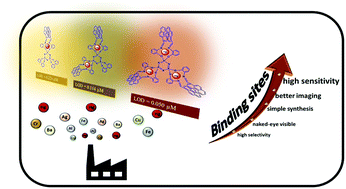A systematic series of fluorescence chemosensors with multiple binding sites for Hg(ii) based on pyrenyl-functionalized cyclotriphosphazenes and their application in live cell imaging†
Abstract
A systematic series of fluorescence chemosensors (1–3) having one, two and three-metal binding sites based on cyclotriphosphazene derivatives bearing bis-, tetra- and hexakis-2-(pyren-1-yl methylene amino) phenoxy units, respectively, were designed, synthesized, and evaluated for their sensing behaviors toward metal ions using UV/Vis and fluorescence spectroscopies. Upon the addition of Hg2+ in both the absence and presence of competitive metal ions, the chemosensors revealed highly selective and sensitive “turn-on” emission enhancement based on the combined effects of chelation-enhanced fluorescence (CHEF), C![[double bond, length as m-dash]](https://www.rsc.org/images/entities/char_e001.gif) N isomerization and intramolecular pyrene excimer formation, as well as a color change from yellowish to colorless, which was readily detected by the naked eye. According to the Job plot method, the complexation ratios of chemosensors (1–3) with Hg2+ were found to be 1 : 1, 1 : 2 and 1 : 3 (ligand : metal), respectively, consistent with the proposed number of metal binding sites. Furthermore, the binding modes of chemosensors (1–3) with Hg2+ were supported by 1H NMR spectroscopy. The increasing complexation ratios from 1 : 1 to 1 : 3 for chemosensors (1–3) enabled proportionally decreasing values for the detection limit (LOD) with 0.223 μM, 0.114 μM and 0.050 μM, respectively. The cytotoxicity and fluorescence microscopy experiments also demonstrated that chemosensors (1–3) are non-cytotoxic, and can be used as fluorescence imaging sensors for Hg2+ in living cells.
N isomerization and intramolecular pyrene excimer formation, as well as a color change from yellowish to colorless, which was readily detected by the naked eye. According to the Job plot method, the complexation ratios of chemosensors (1–3) with Hg2+ were found to be 1 : 1, 1 : 2 and 1 : 3 (ligand : metal), respectively, consistent with the proposed number of metal binding sites. Furthermore, the binding modes of chemosensors (1–3) with Hg2+ were supported by 1H NMR spectroscopy. The increasing complexation ratios from 1 : 1 to 1 : 3 for chemosensors (1–3) enabled proportionally decreasing values for the detection limit (LOD) with 0.223 μM, 0.114 μM and 0.050 μM, respectively. The cytotoxicity and fluorescence microscopy experiments also demonstrated that chemosensors (1–3) are non-cytotoxic, and can be used as fluorescence imaging sensors for Hg2+ in living cells.



 Please wait while we load your content...
Please wait while we load your content...